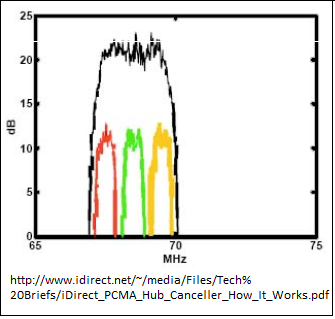I suggest you contact iDirect and ask if they can introduce you to someone who has PCMA working with iDirect. Someone else may answer you here but it is worth checking with iDirect in case someone can be helpful.
Also, ask iDirect to help you with your proposed system design. Talk to your satellite owner also, as you will need to reduce your lease bandwidth and arrange overlap. What cost savings will apply ?
Regarding network. The idea will not work if your hub beam and remote beam are cross-strapped, for example your hub is in a North America beam and your remotes are in South Africa spot beam. So the starting point needs to be that you can see all your own signals.
I don't understand why you should have to buy new RF equipment. Surely all you need do is move the return link frequencies into the same range as your hub outlink.
Regarding a possible problem... The idea is that once the outlink carrier canceller is turned ON, your hub analyser screen will see your own outlink carrier disappear (down by 25 dB or more) and allow the return links from your remotes to be visible and received at the hub. That sounds good. I am not too sure what happens at the remotes. They will see the big outlink carrier from the hub unchanged but superimposed they will see a load of small bursts from the remotes themselves. Hopefully the interference from the composite addition of all the return link bursts will be at least 10 dB below the outlink carrier level
so that the outlink transmission to the remotes will still work. Check that your burst spectral density is well down. If you are using a smallish dish as the hub and largish VSAT remotes then the difference may be less... The uplink G/T and gain setting of the satellite transponder are also factors.
This explanation document:
https://www.idirect.net/~/media/Files/Tech%20Briefs/iDirect_PCMA_Hub_Canceller_H... from iDirect shows a remote site receive spectrum like so:

Note how important it is that the total interfering power of all the return link transmissions do not interfere unacceptably with the remotes reception of the outlink.



